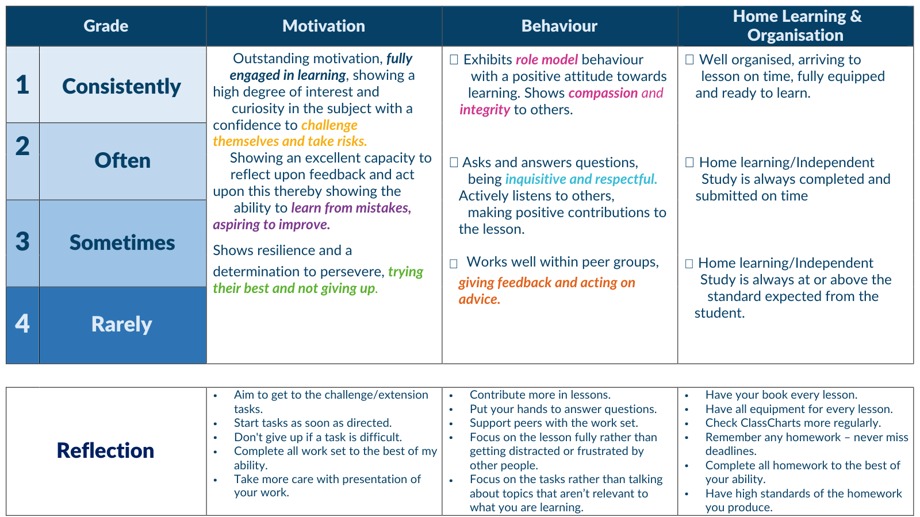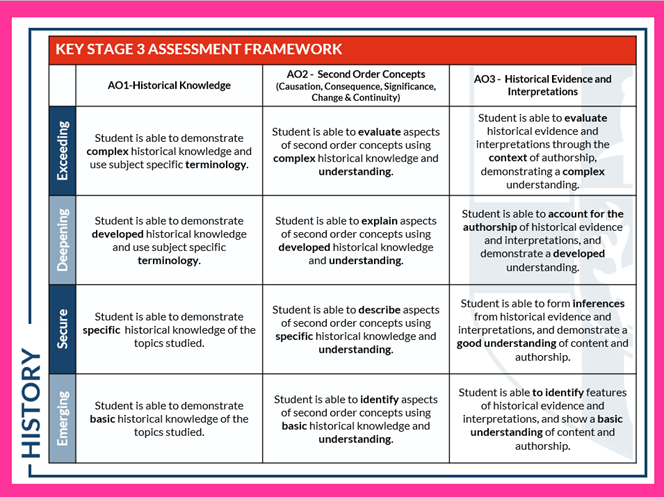- Home
- Curriculum
- Reporting and Assessment
Reporting and Assessment
Throughout the academic year, parents/carers and students receive progress reports providing a range of academic information about the student's current performance.
ATTITUDE TO LEARNING
The report summarises their current attitude to learning. A grade will be awarded in three areas across all subjects based upon the student's Motivation, Behaviour for learning and Homework & Organisation. When grading a student, teachers consider how consistently they demonstrate the attributes within the grid below.
A positive attitude to learning is a vital aspect in the development of your child and we would like you to make this a priority focus when receiving their progress report. Allowing students to adopt a growth mind-set and not having limitations will encourage them to focus on the possibilities of what they can achieve with hard work, dedication and resilience.

After a progress report, students spend time during tutor time to reflect and set targets. For support with how to use the progress report, a summary of the parent support session ran this year can be found here under historic parent sessions.
KEY STAGE 3
EXPLANATION OF THE KEY STAGE 3 ASSESSMENT SYSTEM
Charters' Key Stage 3 assessment model was introduced in response to the government’s decision to remove the requirement on schools to report using national curriculum levels. It is now the responsibility of all secondary schools to put in place their own assessment system for Key Stage 3 (Years 7 to 9).
We have developed a system that is clear and understandable for parents/carers and students and has some coherence with the assessment systems used in primary schools.
Students are set an aspirational target band for all their subjects and work towards this each year. Targets are set combining a range of key factors:
- Key Stage 2 SATS performance in reading and Mathematics (if sat)
- Performance throughout the school, including the outcomes from the Cognitive Abilities Tests (CATs) that they take during September of Year 7
Students will either be set a target of Emerging, Secure, Deepening or Exceeding for each subject.
Emerging - Students are beginning to grasp some of the ideas and skills within a subject, gaining the foundational skills needed to progress within their subject areas.
Secure - Students have a good understanding and knowledge of the curriculum content and can revisit previous knowledge or skills.
Deepening - Students demonstrate a strong understanding of content and have learnt all the knowledge or acquired all the skills to apply their understanding successfully.
Exceeding - Students demonstrate complete competency within a subject and have the depth of understanding to apply a mature response for their age.
The targets that are generated are a flightpath to what they are then 'most likely to achieve' in KS4. The grid below gives an indication of what grades a student is likely to achieve if they go on to make the expected level of progress across KS3, particularly in English and maths.
If making expected progress, students will achieve their target band each year, as they meet the increased demands of each subject. We do understand that not all progress is linear and therefore peaks and troughs can be expected without concerns being communicated home.
We also factor in any further progress students may make during this time as well as the different skills required in specialism subjects, reviewing targets to ensure students are supported and challenged to the appropriate level. Setting will also not be dictated purely by the target grades; teachers use all gathered data over time to ensure students are in the correct class. We feel strongly that the target grades shared with students do not become a ceiling and that whilst an indicative grade can ensure they know where they should be working at, they are capable of achieving greater.
KS3 ASSESSMENT GRIDS
Student progress is measured using our KS3 subject specific Assessment Frameworks Grids that have been created in line with Ofqual Assessment Objectives used at KS4. The grids are used by both teachers and students to enable students to know where they are and how to improve further. An example of a KS3 grid is below.

All KS3 Assessment Framework Grids can be viewed here.
YOUR CHILD’S PROGRESS REPORTS IN KEY STAGE 3
Year 7
Progress will be reported to parents/carers twice for the core subjects (English, Mathematics and Science) and once for all other subjects. This is to ensure that subject teachers have a good understanding of your child based on the learning completed through the year.
Year 8 and 9
Progress will be reported to parents three times each academic year for the core subjects (English, Mathematics and Science) and twice for all other subjects.
CURRENT GRADE
The grade in this column indicates a professional estimate that subject teachers believe your child is currently working at. This should be looked at in comparison with the KS3 Target Banding column however the colour coding will allow you to clearly see whether your child is making more than expected progress (blue), expected progress (green), less than expected progress (yellow) or significantly less than expected (red)
KEY STAGE 4
EXPLANATION OF THE KEY STAGE 4 ASSESSMENT SYSTEM
At Key Stage 4, students are set an aspirational target band in the Summer term of Year 10. Targets are set combining a range of key factors:
- Key Stage 2 and/or CAT scores
- Progress made at Key stage 3
- Data from assessments and progress given in Year 10
- Student wellbeing
The banding encompasses all subject target grades, for example, 678. The aim is for students to achieve an estimated grade of a 6, 7 or 8 in all their subjects. This allows students to know whether they are making expected progress whilst minimising the pressures or glass ceiling that specific target grades can bring.
EXPLANATION OF THE KEY STAGE 4 ASSESSMENT SYSTEM
At Key Stage 4, students are set an aspirational target band in the Summer term of year 10. Targets are set combining a range of key factors: Key Stage 2 and/or CAT scores Progress made at Key stage 3 Data from assessments and progress given in year 10 Student wellbeing
The banding encompasses all subject target grades, for example, 678. The aim is for students to achieve an academic prediction of a 6, 7 or 8 in all their subjects. This allows students to know whether they are making expected progress whilst minimising the pressures or glass ceiling that specific target grades can bring.
ESTIMATED GRADE
The grade in this column indicates a professional prediction that teaching staff believe your child will achieve at the end of Key Stage 4 (Year 11) based on how they are currently performing.
GCSE QUALIFICATIONS
All GCSE qualifications will be a grade between 1 and 9. A grade 4 is a standard pass, 5 a strong pass.
VOCATIONAL QUALIFICATIONS
All vocational qualifications will be graded as a pass, merit, distinction or distinction* at a level 1 or 2.
For both GCSE and vocational qualifications, the estimated grade will also have a letter which is linked to a likelihood of your child achieving that grade. The letters are explained below.
a Confident that the grade predicted will be achieved
b Should achieve the grade predicted
c At risk of falling to the grade below that predicted.
SCIENCE ENTRY LEVEL CERTIFICATE
Students working towards the Entry Level Certificate (ELC) have been awarded grades in line with the grades they are expected to achieve in the ELC. These grades contain two components, a letter and a number. The letter, S or D, stands for single or double and has been awarded based on the number of assessments the student has completed. To achieve the double award students must complete all assessments, four for each science, but for the single award only two assessments are required in each science. If a student is not on course to complete enough assessments to be able to pass the single award they have been given a U grade. The number portion of the grade is the level the student is working at, 3 is the highest grade available for this qualification and 1 the lowest.
KEY STAGE 5
EXPLANATION OF THE KEY STAGE 5 ASSESSMENT SYSTEM
At Key Stage 5, students are set an aspirational target in the October of year 12. Targets are set based on the average GCSE point score that students achieve across all their GCSEs. These targets are reviewed by staff before being finalised.
BTEC, and A level qualifications are awarded using the following grading system. Some universities will make offers based on a score rather than grades and so the current conversions are included here for your convenience.
| A LEVEL | BTEC LEVEL 3 | EQUIVALENT UCAS POINTS |
| A* | D* (Distinction *) | 56 |
| A | D (Distinction) | 48 |
| B | - | 40 |
| C | M (Merit) | 32 |
| D | - | 24 |
| E | P (Pass) | 16 |
| U |
| |
ACADEMIC PREDICTION
The grade in this column indicates a professional prediction that teaching staff believe your child will achieve at the end of Key Stage 5 (Year 13). The grade will also have a number which is linked to a likelihood of your child achieving that grade. The numbers are explained below.
1 Confident that the grade predicted will be achieved
2 Should achieve the grade predicted
3 At risk of falling to the grade below that predicted
Please note that the grade awarded for a subject between one Progress Report and another may go down or up or stay the same, depending on the nature of the work undertaken. If there are any concerns, the class teacher will be in touch if they haven’t already.
WEBSITE LINKS TO SUPPORT YOUR CHILD
- You can find out what they are learning in the Course Outlines section of each subject page here


